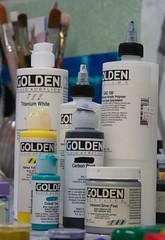
Various Golden Acrylics
You go into the art supply store looking for a single color - to replenish your ultramarine perhaps - but walking along the aisle you are distracted by the jars and bottles, the shiny colors, the fluid colors... You leave the store three hours later with a bag full of goodies and a considerably lighter wallet.
How did that happen?
A month later most of those goodies still stand unopened in your studio.
There are a myriad of gels, mediums and additives for acrylic paint, not to mention all the specialty colors on top of the full color range. Where to start?
Tube Colors
Most people, whether coming from oils, or painting for the first time, start with the tube paints. These can be used 'as is' or diluted with water or acrylic mediums. I recommend having a damp brush and clean water to hand even if you use them straight from the tube because the rapid drying of acrylic paint can make them sticky and harder to brush in a matter of moments. For this reason, squeeze out a little at a time and/or use a "Stay Wet" type palette.
You will know when the paint is starting to become dry and sticky when you feel a resistance to your movement as the brush starts to drag in the paint. At this point stop brushing unless you want a lumpy mess for a paint surface!
Fluid Acrylics
These come in squirt bottles and have an intense pigment load so used as is they are very vivid. They are wonderful for mixing with glazing and matte mediums as they are a similar viscosity (more on all that below).
Open Acrylics
I haven't used these, but Golden (who make the OPEN acrylics) advertise them as extending the workable time of acrylics - that's the time you have to do any blending or brushing before the paint gets to that sticky stage I mentioned. If you use these please comment below - I would love to post your experience here (with a link to your blog or website).
Matte Medium
The most versatile and essential medium ever, in my opinion at least! It makes a great glue for collage or just sticking stuff into a sketchbook. Mixed with acrylic colors it dries with a matte surface. I have also used it to seal edges when taping. It is very fluid (about the same viscosity as thin cream) and mixes best with fluid acrylics, but can also be used with the tube colors - just add the medium bit by bit to the tube color. It dries with a very slight haze so be careful when layering it over other colors.
Glazing Medium
Glazing mediums come in all finishes, from glossy to satin, and are useful for thinning a color down to glaze. Why not simply thin the paint with water? Well, you can, but you have to be careful how far you thin with water. Too far and there is not enough binder (the acrylic base) to hold the pigment on the canvas. When you add Glazing medium you are adding more binder to hold the pigment glaze on the canvas. And yes, you can use water and glazing medium together. Glazing medium dries totally clear.
Adding either of the above mediums to your paint also extends the 'open' time - that is the time the paint is workable before stickiness sets in. Golden also have an OPEN acrylic medium (gloss) and an OPEN Thinner which can be used to extend that time even further.
Viscosity
Viscosity is basically the thickness of the paint - the tube paints have a high viscosity because thickeners are added, the fluid acrylics have a low viscosity. A thicker paint shows brush strokes more easily and can hold texture. There are lots of mediums that make thick paint even thicker but we will come to that another time...
In mixing paints of different viscosity, e.g. tube paint and matte medium, I have found that it is easier to start with the thick paint (in this case the tube paint) and gradually add the thinner paint or medium (the matte medium). Adding thick to thin only results in lumps that never seem to go away, get caught in my brush and appear where I least want them on the canvas! It's a bit like making a white sauce from scratch, adding the milk slowly bit by bit to the butter-flour mix.
More on some of the other gels and mediums available in an upcoming post. If you haven't checked out Golden's website you should - lots of good information there. They also have a great newsletter Just Paint with all kinds of articles about paint and color. I am not in the pay of Golden (sadly) - I just love using their paints. However, I did once work for a large manufacturer of acrylic emulsions (the raw binders and thickeners), as a chemical engineer on the acrylic plant, so I have some experience and background knowledge of the acrylic bases of these paints.
Now, get in your studio and dust a few mediums down! Let me know how you get on...




great post..I get so frustrated with acrylics..so I do watercolors and oils..but sometimes I get out the acrylics..I do love matte medium for lots of uses!
ReplyDelete